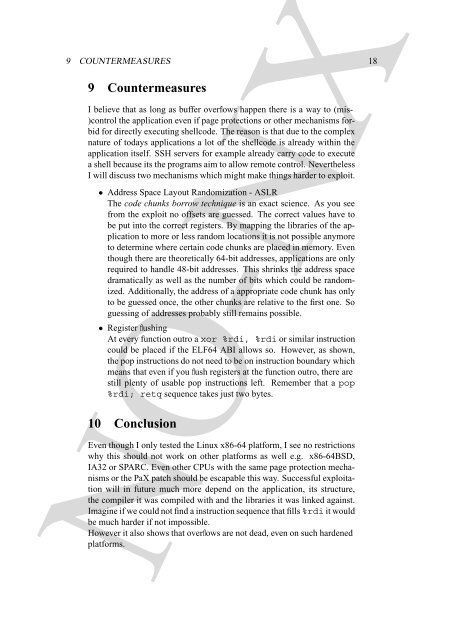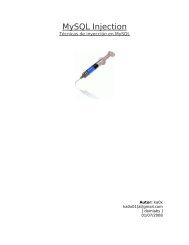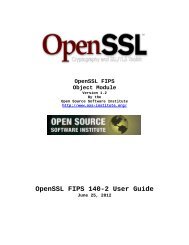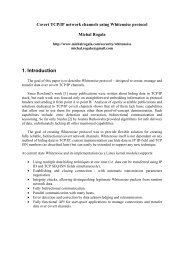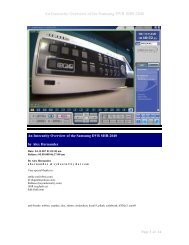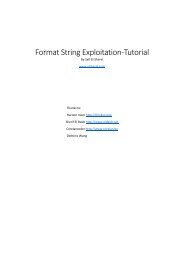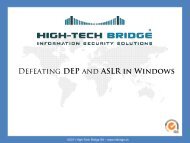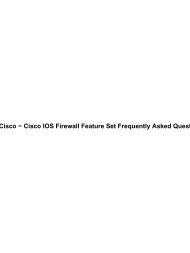x86-64 buffer overflow exploits and the borrowed code chunks - SuSE
x86-64 buffer overflow exploits and the borrowed code chunks - SuSE
x86-64 buffer overflow exploits and the borrowed code chunks - SuSE
Create successful ePaper yourself
Turn your PDF publications into a flip-book with our unique Google optimized e-Paper software.
9 COUNTERMEASURES 18<br />
9 Countermeasures<br />
I believe that as long as <strong>buffer</strong> <strong>overflow</strong>s happen <strong>the</strong>re is a way to (mis-<br />
)control <strong>the</strong> application even if page protections or o<strong>the</strong>r mechanisms forbid<br />
for directly executing shell<strong>code</strong>. The reason is that due to <strong>the</strong> complex<br />
nature of todays applications a lot of <strong>the</strong> shell<strong>code</strong> is already within <strong>the</strong><br />
application itself. SSH servers for example already carry <strong>code</strong> to execute<br />
a shell because its <strong>the</strong> programs aim to allow remote control. Never<strong>the</strong>less<br />
I will discuss two mechanisms which might make things harder to exploit.<br />
• Address Space Layout R<strong>and</strong>omization - ASLR<br />
The <strong>code</strong> <strong>chunks</strong> borrow technique is an exact science. As you see<br />
from <strong>the</strong> exploit no offsets are guessed. The correct values have to<br />
be put into <strong>the</strong> correct registers. By mapping <strong>the</strong> libraries of <strong>the</strong> application<br />
to more or less r<strong>and</strong>om locations it is not possible anymore<br />
to determine where certain <strong>code</strong> <strong>chunks</strong> are placed in memory. Even<br />
though <strong>the</strong>re are <strong>the</strong>oretically <strong>64</strong>-bit addresses, applications are only<br />
required to h<strong>and</strong>le 48-bit addresses. This shrinks <strong>the</strong> address space<br />
dramatically as well as <strong>the</strong> number of bits which could be r<strong>and</strong>omized.<br />
Additionally, <strong>the</strong> address of a appropriate <strong>code</strong> chunk has only<br />
to be guessed once, <strong>the</strong> o<strong>the</strong>r <strong>chunks</strong> are relative to <strong>the</strong> first one. So<br />
guessing of addresses probably still remains possible.<br />
• Register flushing<br />
At every function outro a xor %rdi, %rdi or similar instruction<br />
could be placed if <strong>the</strong> ELF<strong>64</strong> ABI allows so. However, as shown,<br />
<strong>the</strong> pop instructions do not need to be on instruction boundary which<br />
means that even if you flush registers at <strong>the</strong> function outro, <strong>the</strong>re are<br />
still plenty of usable pop instructions left. Remember that a pop<br />
%rdi; retq sequence takes just two bytes.<br />
10 Conclusion<br />
Even though I only tested <strong>the</strong> Linux <strong>x86</strong>-<strong>64</strong> platform, I see no restrictions<br />
why this should not work on o<strong>the</strong>r platforms as well e.g. <strong>x86</strong>-<strong>64</strong>BSD,<br />
IA32 or SPARC. Even o<strong>the</strong>r CPUs with <strong>the</strong> same page protection mechanisms<br />
or <strong>the</strong> PaX patch should be escapable this way. Successful exploitation<br />
will in future much more depend on <strong>the</strong> application, its structure,<br />
<strong>the</strong> compiler it was compiled with <strong>and</strong> <strong>the</strong> libraries it was linked against.<br />
Imagine if we could not find a instruction sequence that fills %rdi it would<br />
be much harder if not impossible.<br />
However it also shows that <strong>overflow</strong>s are not dead, even on such hardened<br />
platforms.<br />
NO-NX


